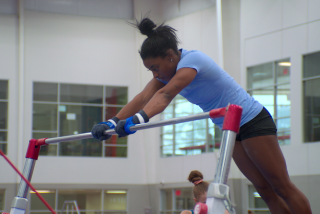Australian Not Horsing Around This Time : Triathlon: Jones has taken to her new endeavor quite swimmingly.
- Share via
DEL MAR — She came, like many before her, because “here is where triathlon is.”
North County is a hotbed for training-minded triathletes, many of them foreign, many of them local, most of them good.
Michellie (pronounced Mick-AYE-lee) Jones moved to Del Mar five months ago from Australia, where she was a promising equestrian.
But Jones, 22, decided horsing around wasn’t going to make her a world-class athlete. So she traded in hoofs for spokes, saddles for pedals and hay for Ben Gay.
“(Triathlon) was something that just came about,” said Jones, who will compete Sunday morning in the Danskin Women’s Triathlon Series at Mission Bay. “It was circumstances more than anything else.”
It was no fluke, however, that Jones landed in San Diego, where she came to compete with the best and make a name for herself.
“It means a lot to see how the Australians do against the top Americans,” said Jones, Australia’s 1991 Triathlete of the Year and currently the top-ranked triathlete there. “It’s very important that you race well over here.”
Jones has picked up three sponsors in her short stay in the U.S., and her recent performances have increased her credibility. In the first three stops on the Danskin circuit, Jones has placed second twice and fifth, and she won the Bud Light series stop in San Diego less than two weeks ago. On Tuesday, she will fly back to Australia, where she will continue to train for the Oct. 13 World Championships in Queensland.
While Jones has proven adept at several triathlon distances, she is particularly fond of the sprint races, which Sunday’s is.
“I like it because it’s so fast,” she said. “You can be a great 5K runner, but you still have to get out of the water fast and have a great bike segment. You have to have quick transitions. If you lose anything, anywhere, you won’t be the first one over the line.”
The shorter distances appeal to the masses, further promoting the sport.
“It’s a great distance for anyone, from beginners to pro, so it has a wide appeal,” she said. “We need to increase the amount of people getting involved, helping with the development of the sport across the board, from people doing it for the first time to pros making money and getting sponsorship.”
She also finds a lot to like about the all-woman format, which is unique in a sport where the women traditionally compete alongside the men.
“Usually there’s only one press truck and no one ever knows what the women are doing, so it’s nice, because the men can’t take anything away,” she said. “It’s a chance to show that we are as competitive as the men.”
Jones said Australia women have a harder time proving themselves as legitimate athletes than women do in the United States.
“In Australia, it takes time,” she said. “There’s a bit of an attitude problem there. It’s a little more male-oriented. It’s nice to come over here and see the difference.”
Most professional triathletes come from backgrounds in cycling, running or swimming, but Jones only dabbled in running in high school.
“I started running when I was 17, but I didn’t think I could do much with it,” she said.
When her high school coach introduced her to aquathon (what a swim-run race is called in Australia), biathlon and triathlon were the natural progressions.
“That got me interested,” she said. “Before then, I had no idea what they were.”
Toward the end of 1988, Jones entered her first triathlon--not as an amateur but as a pro. The 1989 season was her first full racing season.
Jones would like to cap off her triathlon career with a world championship, but her world won’t crumble if it doesn’t happen.
“I’d like to win one, see the world, make some financial gains, but there are other things I want to do,” said Jones, who eventually wants to use the teaching degree she earned in December 1990 from a college in Wollongong, on the south coast of Australia.
It may be some time before she gets back into the classroom. In a sport where the women peak from approximately 28 to 32, Jones is a relative newcomer.
“I have to believe it is like this because of the endurance (required),” she said. “I see myself with a greater percentage of improvement than the (older) girls at the top right now, because there’s a greater chance for me to improve. But by the time I’m up there, there will be other, younger girls improving.”
Triathlon Notes
The Danskin Women’s Triathlon Series stopped in three cities in its 1990 debut. Now, in its second year, it has expanded to four cities with San Diego the final stop. This all-woman series, the first of its kind, is worth $10,000 in prize money. The sprint distance begins with a half-mile swim, followed by a 12.4-mile bike segment and a 3.1-mile run. . . . Karen Smyers of Medford, Mass., who won stops in White Plains, N.Y., San Jose and Milwaukee, has already won the series. Smyers, the 1990 World Triathlon champion, won’t compete here but is flying in to accept a car she has won. . . . In her absence, favorites in San Diego are Michellie Jones and Encinitas’ Paula Newby-Fraser, the three-time Ironman champion and 1988 Coke Grand Prix winner. Jones and Newby-Fraser finished second and third in Milwaukee and San Jose. . . . Other elite athletes racing Sunday include Colorado’s Colleen Cannon, the 1990 National Sprint champion; Seattle’s Joan Hansen, the 1990 U.S. Amateur Triathlete of the Year; and Leucadia’s Lisa Laiti, who won the Long Beach Danskin event last year. . . . The winner earns $1,000, with second and third worth $750 and $500.


